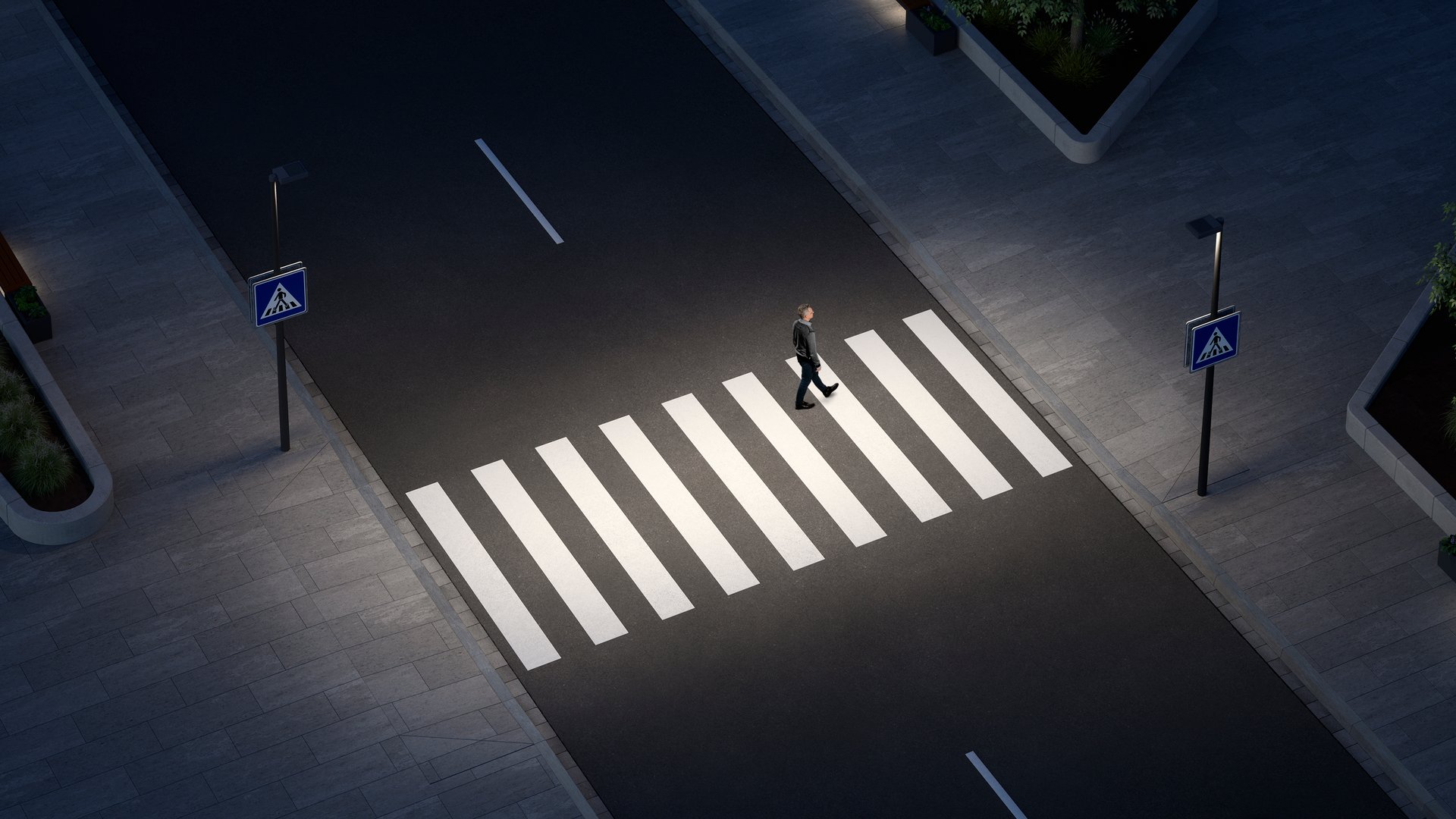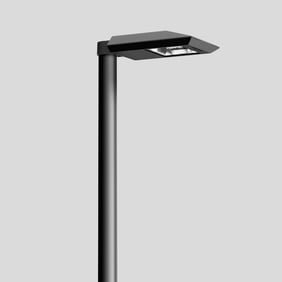
Pedestrian crossings are essential and efficient control facilities for the safety of all road users. These solutions for crossing roads are particularly important for children and young people as well as for elderly people, who require particular protection. Standard-compliant illumination extends the visibility offered by light during twilight and in the dark. This can prevent serious accidents.

Ēv = 30 lx measured at a height of 1 m at defined measurement points in the direction of approach Ev min ≥ 4 lx at a height of 1 m
Pedestrian crossings and crossing aids
Standard-compliant light for security and comfort
Strict standards for illumination ensure that pedestrians can cross the road safely even at night using suitably designed crossings with optimal visibility and without generating any glare for all road users: Additional illumination with a high vertical component is obligatory in the vicinity of these pedestrian crossings. Efficient additional illumination is also effective for crossing aids, such as narrowed carriageways, central reservations, centre islands or speed humps, for which the regulations are less strict as a rule.
In contrast, the characteristics of pedestrian crossings are regulated very precisely by law. This relates not only to the markings on the road and corresponding traffic signals, but also to the illumination: the safety of pedestrians when crossing the road should and must be continuously guaranteed during the day as well as in the dark.
The absolute necessity of vertical illumination components While pedestrian crossings with a traffic light – that is, a pedestrian light – are considered to be “conflict zones” in roadways from a lighting perspective and must be illuminated accordingly, specific rules only apply for crossings marked with signs. Pedestrians must be easily visible here from both directions of approach even when it is dark or in rainy conditions – and this applies both on the crossing itself as well as in the waiting areas at the edge of the road: For this reason, additional permanent illumination is generally required, the design of which is stipulated in standards DIN 13201 and DIN 67523.

In order to make people stand out brightly against their background, predominantly vertical illumination components are needed. To this end, luminaires for pedestrian crossings with asymmetrical light distribution are arranged so that the crossing and waiting zones are illuminated highly efficiently from the respective direction of approach. A contrast in light colour from the rest of road lighting also attracts further attention.
Initially implemented in the past with monochromatic yellow sodium vapour low-pressure lamps, then with sodium vapour discharge lamps, these requirements can now be effectively and sustainably fulfilled with corresponding LED pedestrian crossing luminaires. Overnight shut-down of additional lighting is not permitted in principle. According to the regulations, highlighting the crossing with light in this manner can only be dispensed with if the requirements of illumination class ME2 are fulfilled on both sides of the pedestrian crossing over a longer distance and generally in the dark.
Practical illumination even for crossing aids Wherever the requirements are not fulfilled for establishing a pedestrian crossing on roadways according to the specified criteria, crossing aids can be implemented to assist pedestrians when crossing the street. These include measures such as narrowing the carriageway by extending side areas, installing speed humps or carriageway dividers. Illumination is not mandatory here, but according to the “Recommendations for illuminating pedestrian crossing aids” of DIN standards committee FNL 11, illumination in accordance with DIN EN 13201 improves awareness of these zones for all road users.
Source: licht.de
A brief overview of the requirements

Additional lighting at pedestrian crossings
- The illumination must illuminate the pedestrian crossing and the adjacent waiting zones in the respective direction of approach.
- Illumination directly over the centre axis of the crossing is not standard-compliant and therefore is not permitted.
100 m before and after the pedestrian crossing, the luminance of the road must be at least 0.3 cd/m2. The level of existing street lighting should be increased accordingly, if necessary.

- A maintained illuminance of 30 lx (mean vertical illuminance) must be achieved at fixed points on the central axis of the crossing at a height of 1m.
- The value must not fall below 4 lx (minimum vertical illuminance) at any of the evaluation points defined in the evaluation field, nor in the waiting zone at a distance of 1 m from the road.
- The illumination at the pedestrian crossing must not be switched off during the hours of darkness.
- It must be possible to switch the lighting system for pedestrian crossings independently from other light sources.

